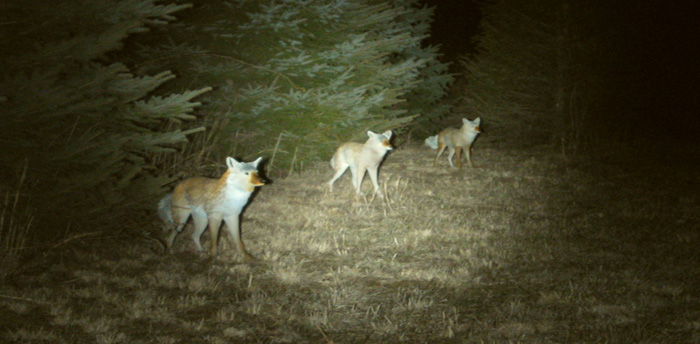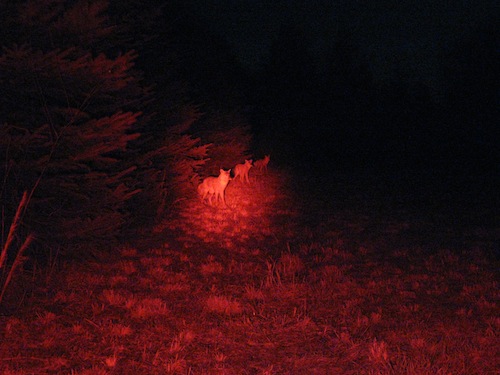It was early evening when a prime red fox responded to my calls and was closing the distance from 100 yards away. I continued lip-squeaking, enticing him closer with each squeak. We played this cat and mouse game until I guessed he was 30 yards out.
The time to shoot had arrived! One shot from my 12-gauge and the fox ran off into the dark and out of my life. How could this be? Out of curiosity I marked a tuft of grass where the fox stood and paced off the distance — 43 yards! Once again I had incorrectly estimated the distance.
That hunt took place more than 30 years ago when I was still somewhat green, but I learned a valuable lesson that night that I never forgot. I had to learn how to judge distance at night if I was going to be a successful fox hunter.
Night Vision
The first thing you notice about night hunting is the lack of color. We see shades of gray, brown, and black, but very little color. Also, everything seems “closed-in” all around you.
This combination of feeling closed-in and lack of color are what causes us to lose depth perception, resulting in misjudging distances. It’s like being in a boat in the middle of a lake. It’s difficult to judge distance over open water. The same holds true at night.
Check Your Light
Before you can learn to judge distance at night, you have to know what kind of beam your light produces. Is it a small hand-held light, a 6-volt headlight or a large spotlight?
Your light source determines how much of the area in front of you is illuminated at a certain distance. This is a critical component to the equation, and one, which you must understand to be able to accurately estimate distance.
Try the following exercise to help you learn to judge distance, simply by the size of your light beam. During the day, in an open field, place markers at 20, 30 and 40 yards from a base location. However, feel free to put them at distances related to your hunting situation. I like this setup (20, 30 and 40 yard markers) because that’s the distance I shoot most of my fox.

The purpose of this exercise is to give you practice in visualizing how much area your light source illuminates at a given distance. Also, for this exercise, it’s very important to use the same light you will be hunting with.
Life-Size Markers
Your next step is to try the same exercise using an object the same size as the animal you are primarily hunting.
For instance, if you are hunting fox, find an object or make a cardboard cutout the size of a fox. Your best choice would be to use a stuffed fox. If you’re after coyotes, use a coyote-sized object. My coyote decoy, the “Masters Series Lone Howler” by Flambeau, worked perfectly for this exercise.

Next, move the decoy to the 30-yard marker. Just as before, shine your light on the decoy and observe the same results. It will appear smaller and less illuminated at this distance. Repeat these steps at your 40-yard marker, making mental notes of the two key components. If you have a 50-yard marker, repeat the exercise at that distance also. I am always amazed at how far the decoy appears, even at 30 yards, let alone 40. What you will find is that darkness plays tricks on our visual senses.
Once you have finished the entire exercise from all markers, you might want to repeat the process a second time, starting again at the 20 yard marker. If you’re really serious, you might repeat this exercise three or four times!
Now Change It Up
For added value to your learning process, try positioning the decoy at different angles, such as sideways or head-on before repeating the exercise. Moving the decoy into different positions could also help you in understanding the judging distance process even more. That’s really the whole purpose of these exercises.
Have fun with these simulations at the different distances, but most importantly, learn from each marker. Simulate each hunting scenario, making it as realistic as possible. In doing so, this should give you valuable insight into judging distance. It will also give you the utmost confidence during a real hunt.






